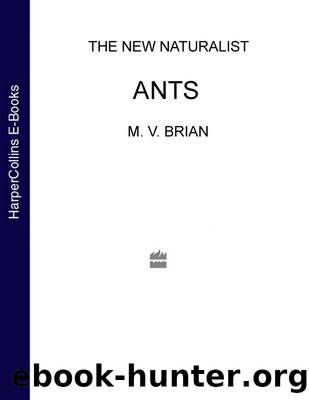Ants by M. V. Brian

Author:M. V. Brian
Language: eng
Format: epub
Publisher: HarperCollins Publishers
Published: 2018-12-19T16:00:00+00:00
CHAPTER 7
BROOD REARING
WORK inside the nest is largely concerned with the conversion of various food substances into ant material and the disposal of any waste products formed in the process.
THE LIFE HISTORY
The life history of ants is like that of most advanced insects. Smooth, white, kidney-shaped eggs yield simple, white, hairless grubs that feed with the aid of workers; they grow and moult several times, becoming hairier each time, until they are big larvae. Then they stop feeding and change into a quiet, metamorphosing pupa from which the adult at length emerges. Though the larvae have no legs they are capable of a few movements; they can bend their head round to touch their tail, move their jaws sideways, swallow liquids and collect them in a simple, tubular midgut where they are digested and absorbed. The midgut is partitioned from the hindgut which is no more than a sac and serves as a bladder for the collection of urine. The whole gut contents are passed out just before metamorphosis. Larvae have large digestive glands with reservoirs that run the whole length of their body and open at the mouth; droplets of a clear saliva which can digest proteins are usually extruded if workers push the larval head back or bite gently in that region but more often it is mixed with the food as it is being swallowed. Each larva contains a set of buds, which are the rudiments of the adult system, distributed throughout its body in appropriate places. These can be recognized quite early in the larval stage as rudimentary legs, wings, ovaries or other organs. They grow and even start to acquire some aspects of their adult shape whilst the larva is still feeding. Later they elongate, join up and secrete the pupal skin; this stage is called a pharate pupa. The larval skin must be cast off before the perfect pupal shape can develop, for this involves a contraction of the front end of the abdomen to form the petiole and an inward telescoping of the hind segments of the gaster. Both these processes inflate the thorax and head with blood. Once this has happened the skin sets hard and during the weeks that follow the adult is constructed inside. In formicine ants a cocoon is spun when the larva has finished feeding and the gut residues are then ejected. These make a black mark at one end. All the pupal transformations take place inside this cocoon.
Download
This site does not store any files on its server. We only index and link to content provided by other sites. Please contact the content providers to delete copyright contents if any and email us, we'll remove relevant links or contents immediately.
The Lion King by Disney Book Group(679)
Tales from the Ant World by Edward O. Wilson(648)
The Age of Dinosaurs by Steve Brusatte(646)
The DNA Book by DK(622)
The Rainforest Book by Charlotte Milner(588)
The Book of Hope by Jane Goodall(564)
How to Draw Everything by Peter Gray(549)
A Most Remarkable Creature by Jonathan Meiburg(549)
Time To Go by Time To Go (epub)(546)
Figaro and Rumba and the Cool Cats by Anna Fienberg(540)
Small Favors by Erin A. Craig(532)
The Valley and the Flood by Rebecca Mahoney(504)
Don Cherry's Hockey Stories and Stuff by Don Cherry(497)
Dirty Beasts by Roald Dahl & Quentin Blake(492)
Ants by M. V. Brian(488)
Fox 8: A Story by George Saunders(486)
Beginner's Bet by Fiona Riley(466)
Paper Heart by Cat Patrick(463)
Rescue on the River by Marianne Hering & Sheila Seifert(460)
